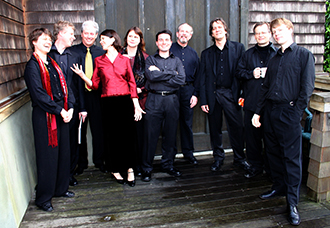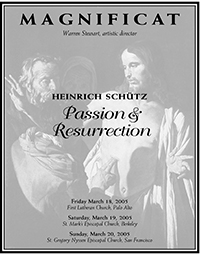2004-2005 – Magnificat’s 13th Season
 Magnificat was especially active in the 2004-2005 season, performing four programs on our own series while also appearing on the San Francisco Early Music Society concert series and returning for an engagement with the Music Before 1800 series in New York City. Each program focused on the work of a single composer: Carissimi, Monteverdi, Rovetta, Charpentier, Cozzolani, and Schütz.
Magnificat was especially active in the 2004-2005 season, performing four programs on our own series while also appearing on the San Francisco Early Music Society concert series and returning for an engagement with the Music Before 1800 series in New York City. Each program focused on the work of a single composer: Carissimi, Monteverdi, Rovetta, Charpentier, Cozzolani, and Schütz.
The season opened with a program devoted to the music of Iacomo Carissimi, featuring two oratorios – Vantitas Vantitaum and Baltazar – a madrigal Fuggi, fuggi, and the allegorical dialogue Alma che fai, che pensi? The program also included two canzoni for two violins and continuo by Frescobaldi and a harpsichord toccata by Michelangelo Rossi. In her San Francisco Classical Voice review, posted on September 28, 2004, Anna Carol Dudley noted “Sopranos Catherine Webster and Jennifer Ellis, tenors Paul Elliott and Scott Whitaker (Elliott mostly singing alto parts) and bass Peter Becker were all at the top of their form, consistently sensitive to the words, spot-on in tuning, varied in their use of dynamics and vocal color, masters of coloratura, peerless in stylistic delineation of recitative and aria — above all, bringing wonderfully expressive music fully to life.” Several works from the San Francisco performance on September 24, 2004 can be streamed and downloaded at Magnificat’s music page.
In November, Magnificat presented works of Monteverdi in a program that featured sopranos Caherine Webster and Jennifer Ellis Kampani and violinists Rob Diggins and Cynthia Freivogel. Vocal works included Zefiro torna and Si dolce e’l tormento as well as Chiome d’oro, Exulta filia Sion, Confitebor tibi Domine, Salve Regina, O come sei gentile, Ed è dunque pur vero and the Lament d’Arianna. The instrumental ensemble contributed two trio sonatas by Marini and a solo sonata of Dario Castello. Michelle Dulak, writing for San Francisco Classical Voice observed “Ellis and Webster have the agility, the accuracy, and the focused sound for this music, in which any of those three qualities being lacking spells major trouble. Agility, for example: Ellis’ coloratura in the solo motet “Exulta filia Sion” (Rejoice, daughter of Zion) and Webster’s in the third “Salve Regina” from the Selva morale were marvelous.
The following month, Magnificat was presented by the San Francisco Early Music Society in a Christmas Vespers featuring music by Giovanni Rovetta, Monteverdi’s successor as maestro di capella at the basilica of San Marco in Venice. While working in has shadow of Monteverdi has affected Rovetta’s historical position it did not hinder his reputation during his own lifetime as he was one of the outstanding figures in Venetian musical life and he was active as a performer and as a composer of five large vespers collections, four volumes of concertato madrigals, at least two operas and numerous works in anthologies and manuscripts in a career than spanned thirty six years. Though we had previously performed individual works by Rovetta, it was wonderful to have the opportunity to share five psalms and a Magnificat from Rovetta, along with five sonatas by Venetian musician Massimiliano Neri and a motet by Cavalli with the San Francisco Early Music Society audience.
In January, we turned to the music of Marc-Antoine Charpentier in a program featuring two of the composer’s Latin oratorios, or histoires sacrées: Filius Prodigus and the Sacrificium Abrahæ. Representing the most direct link with Charpentier’s teacher Carissimi both in genre and style, Charpentier’s oratorios form a significant if isolated repertoire nearly unique in France, a country that seemed to have little interest in dramatic settings of religious subjects.
 Magnificat’s season concluded with a program featuring two dramatic works of Heinrich Schütz: the Seven Last Words of Christ and the Reusrrection Story. For these concerts Magnificat welcomed back German baritone Martin Hummel and the Sex Chordæ Consort of Viols. Certainly the most striking of Schütz’s innovations in the setting of the Resurrection narrative is his use of a quartet of viols to accompany the evangelist’s words. Adapting a popular vocal style of the period called falso bordone, the viols sustain chords under the stationary reciting tone and bursting into expressive and florid part writing at each cadence. Kip Cranna praised Magnificat’s interpretation Schütz in his San Francisco Classical Voice review noting “This can be difficult repertoire to bring to life, with its narrow-ranged melodies, rhetoric based phrasing, frequent, formulaic cadences, and somber modal hues. Magnificat has mastered this refined art through exacting attention to detail and an obvious love for the music itself… .”
Magnificat’s season concluded with a program featuring two dramatic works of Heinrich Schütz: the Seven Last Words of Christ and the Reusrrection Story. For these concerts Magnificat welcomed back German baritone Martin Hummel and the Sex Chordæ Consort of Viols. Certainly the most striking of Schütz’s innovations in the setting of the Resurrection narrative is his use of a quartet of viols to accompany the evangelist’s words. Adapting a popular vocal style of the period called falso bordone, the viols sustain chords under the stationary reciting tone and bursting into expressive and florid part writing at each cadence. Kip Cranna praised Magnificat’s interpretation Schütz in his San Francisco Classical Voice review noting “This can be difficult repertoire to bring to life, with its narrow-ranged melodies, rhetoric based phrasing, frequent, formulaic cadences, and somber modal hues. Magnificat has mastered this refined art through exacting attention to detail and an obvious love for the music itself… .”
After completing our home season, Magnificat travelled to New York, where we were presented in a return engagement on the Music Before 1800 series. As in 2003, the program featured Chiara Margarita Cozzolani, this time the mass ordinary set in the context of the liturgy for Easter Sunday.
Over the course of the season artistic director Warren Stewart led ensembles that included Peter Becker, Meg Bragle, Hugh Davies, Rob Diggins, John Dornenburg, Jolianne von Einem, Paul Elliott, Jennifer Ellis Kampani, Ruth Escher, Cynthia Freivogel, Amy Green, Martin Hummel, Daniel Hutchings, Boyd Jarrelll, Julie Jeffrey, Tim Krol, Christopher LeCluyse, David Morris, Farley Pearce, Hanneke van Proosdij, Deborah Rentz-Moore, Wolodymyr Smishkevich, David Tayler, Catherine Webster, Scott Whitaker, and David Wilson.